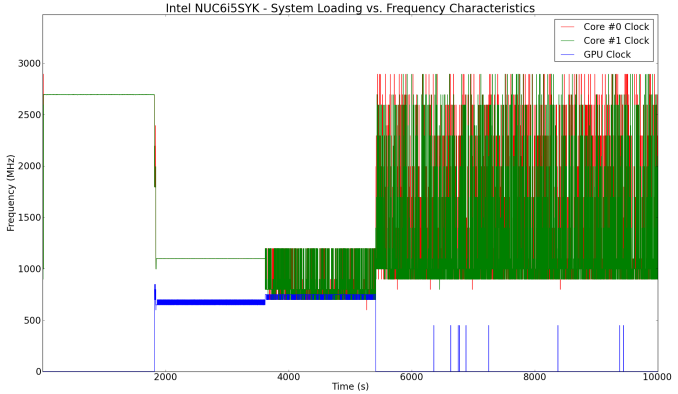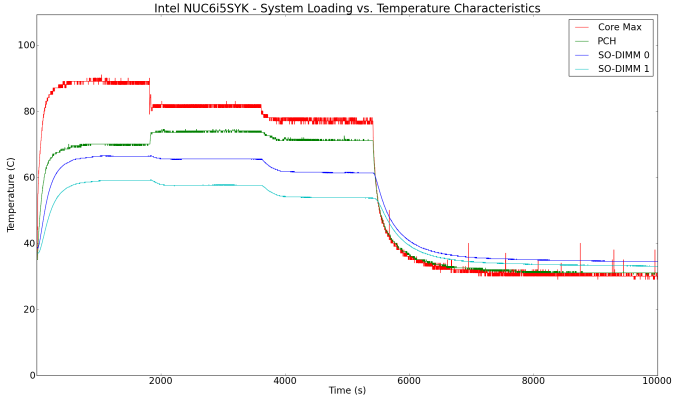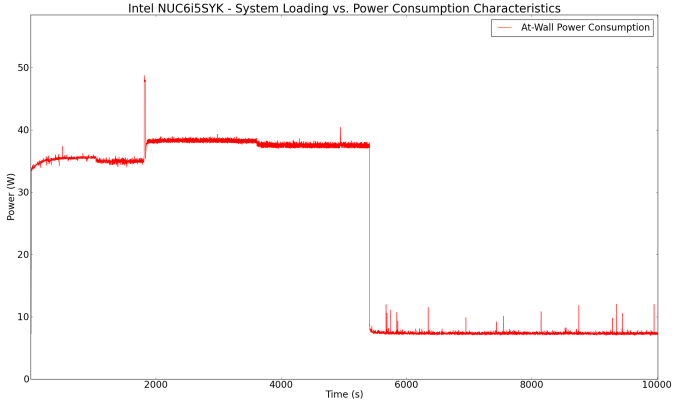The Intel NUC6i5SYK Skylake UCFF PC Review
by Ganesh T S on March 11, 2016 8:00 AM ESTPower Consumption and Thermal Performance
The power consumption of the NUC6i5SYK at the wall was measured with a 1080p display being driven through the HDMI port. In the graphs below, we compare the idle and load power of the Intel NUC6i5SYK with other low power PCs evaluated before. For load power consumption, we ran Furmark 1.12.0 and Prime95 v27.9 together. While the idle power number is consistent with a system sporting a 15W TDP processor, the load power is quite high at 38.37W (considering that the Haswell-based NUCs idled a full 10W lower while also using a 15W TDP processor).


Analyzing the AIDA64 system report and the default BIOS configuration revealed that the unit was optimized for maximum performance. The long duration CPU power limit was set to 23W for a time duration window of 96s and the short duration CPU power limit was set to 30W for 2.44ms. For comparison, the Core i7-6600U in the Surface Book has a long duration CPU limit of 15W for 28s and a short duration limit of 25W for 2.44ms. As we shall see further down in this section, the Core i5-6260U in the NUC6i5SYK doesn't pull back significantly from the 23W limit even under sustained load (despite the 96s configuration).
Moving on to our thermal stress routine, we started with the system at idle, followed by 30 minutes of pure CPU loading. This was followed by another 30 minutes of both CPU and GPU being loaded simultaneously. After this, the CPU load was removed, and the GPU was loaded alone for another 30 minutes. The various clocks in the system as well as the temperatures within the unit are presented below.
We find that the cores spend very little time at the turbo speed of 2.9 GHz, but the steady clock rate is around 2.6 GHz throughout the duration when the CPU was completely loaded. The Core i5-6260U is advertised with a base clock of only 1.8 GHz. There is no throttling at play here even under full CPU load. However, when the GPU gets loaded , the cores drop down to around 1.1 GHz even under load. As we shall see further down, this is probably limited by package power. The GPU cores have a base frequency of 300 MHz (turbo to 950 MHz). Under load, we see it operate between 600 - 700 MHz depending on whether the CPU is loaded simultaneously or not.
According to the official specifications, the junction temperature of the Core i5-6260U is 100C. The thermal solution is more than good enough to maintain the temperature below 90C even under extreme stress. The cores also idle around 33C.
In addition to the frequencies and temperature, we also tracked the power consumption at the wall during the thermal stress testing process. Here, we find that the performance of the system is actually limited by the maximum sustained power consumption limit (around 38W under the tested load conditions) for the system. Irrespective of the CPU and GPU loading, the power consumption is kept under these limits (except for the short spike close to 48W corresponding to the Short Duration Power Limit reported by CPUID).
Since the NUC6i5SYK is not a passively cooled PC, we decided to skip our usual thermal photographs. Given the observed internal temperatures during thermal stress testing and the thermal design (case with adequate number of vents, a blower solution and a plastic lid), we believe that the external case temperatures will not be a cause for concern even under heavy system load.













95 Comments
View All Comments
ganeshts - Friday, March 11, 2016 - link
Hmm.. I haven't seen anyone use 'til now'.But, 'till date' is definitely common where I grew up / learned English: http://english.stackexchange.com/questions/146767/... ; It might not be the best thing to use in other parts of the world, but it is not wrong.
kmo12345 - Saturday, March 12, 2016 - link
I noticed this as well.I also disagree with your statement that it is not wrong. I don't doubt that it has entered common usage in Indian English but I have never heard or seen this phrase in the UK, North America, or even Latin America. So while it may be correct in Indian English it is incorrect in any other forms of English.
nivedita - Sunday, March 13, 2016 - link
The dictionary disagrees with you.http://www.oxforddictionaries.com/us/definition/en...
gietrzy - Friday, March 11, 2016 - link
Can you please point me to Intel white papers pdf where they say m.2 in Skylake can do more than 1600 MB/s?Tia.
ganeshts - Friday, March 11, 2016 - link
Sunrise Point-LP has PCIe 3.0 lanes, and the M.2 slot uses four of them. All I can say is that, with the appropriate M.2 SSD, you can utilize four PCIe 3.0 lanes' bandwidth.jdogi74 - Saturday, March 12, 2016 - link
Sorry, but you sound like a politician. Isn't there some contact at Intel that can provide some reasoning and confirmation for this limit or has Anandtech lost all of it's industry clout?jdogi74 - Saturday, March 12, 2016 - link
I completely agree. It's a shame that this review did not address this issue. Really, it's the only thing I came to this review hoping to learn. I have seen reports from users indicating that the M.2 on these is, for some reason, capped at 1600MB/s.This review states... "full support for PCIe 3.0 x4 M.2 SSDs"... yet there's obviously some other factor that prevents these units from getting the most out of it. Given that, I would expect a review on this site to cover it and at least investigate and explain this limitation so that the readers get a better understanding of when PCIe 3.0 x4 really is PCIe 3.0 x4 and when it's not.
Can anyone explain why this alleged PCIe 3.0 x4 essentially perfoms as if it were PCIE 2.0 x4 or PCIe 3.0 x2.
Really.
jdogi74 - Saturday, March 12, 2016 - link
Sorry, I should also mention that Intel's own specs on these also confirm this 1600MB/s limit. So we know it's there. I just want to understand how it's PCIe 3.0 x4 but then it isn't.ganeshts - Sunday, March 13, 2016 - link
I benchmarked both the SM951 and 950 PRO NVMe SSDs, and the best-case bandwidth (large sequential reads) is around 1710 MBps for both.I have asked my Intel contact for the reason behind this, and I will either update things in this comments thread, or have a separate pipeline piece (depending on the depth of Intel's reply).
TheinsanegamerN - Friday, March 11, 2016 - link
Does this NUC have the ability to up te TDP, like haswell iris NUCs could (going from 15 to 28 watt, allowing both higher boost clocks and longer periods of sustained clock speeds.)?And has intel said anything about the skull canyon NUC, with the GT4e GPU?